

Forces - Air resistance lesson outline incorporating Thinking Dice throughout. With a little planning, a teacher would be able to demonstrate “outstanding” practice, by using the thinking dice progressively, throughout the entire lesson.
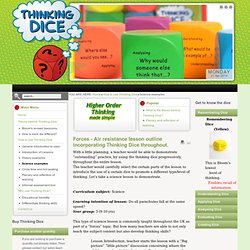
The teacher would carefully select the certain parts of the lesson to introduce the use of a certain dice to promote a different type/level of thinking. Let’s take a science lesson to demonstrate. Curriculum subject: Science Learning intention of lesson: Do all parachutes fall at the same speed? Year group: 5 (9-10 yrs) This type of science lesson is commonly taught throughout the UK as part of a “forces” topic. Lesson Introduction, teacher starts the lesson with a “Big picture” “little picture” discussion concerning where the children are headed in their overall science learning, then focuses on the learning intention at hand and what is going to happen today.
It is here that the yellow dice could be used to “remember” previous lessons that may help today. “Can you explain in your own words our teacher’s problem?” Engineering Interact - Interactive science & engineering for 9-11 year olds. Science Resource Page. Welcome to the new themed science area! Science is a curriculum requirement but many concepts can be difficult for children to understand. I have produced a large number of items that link to many science topics covered in Key Stage 1 and Key Stage 2.
Click on the links below to visit a themed science area or visit the Fact Sheet sections. Please click on the next two buttons for mini workbooks on the topics below. You can also download presentations about the following scientific topics: Magnets, Basic Circuits, Food Groups, Condensation and Evaporation Simple Science Vocab Cards (Electricity or Light and Dark): click the images to download Scientific Enquiry Poster Set: click the image to download Science Vocabulary Flash cards: click the image to download Solids, Liquids and Gases Posters: click on the image to download Reversible and Irreversible Change Posters: click on the image to download New: Food Pyramid A4 Poster: click the image to download.
Creative KS2 topic: micro-organisms. Germs and bacteria seem be a source of fascination for children of all ages.
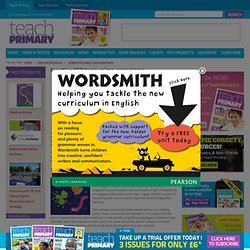
Perhaps it’s the idea of a secret world hidden from the naked eye that intrigues, knowing that there are organisms out there, on us, and all around us. Or maybe it’s just that a lot of children like things that are a bit disgusting! This topic is based loosely on the year 6 QCA unit ‘Micro-organisms’ but contains ideas that could be used in many different ways. Just so you know, I haven’t included any AT1 in this topic as good opportunities for including investigative work are presented clearly within the QCA unit itself. 1.
Generate your own germs… Micro-organisms give us a brilliant opportunity for some imaginative personification, and the creation of germ characters is an engaging introduction to the topic. This activity uses the Domestos bleach adverts as a starting point. 2. Don’t forget your food miles… Micro-organisms. Welcome to Micro-organisms Hello, I'm Dr David Moore and I am a mycologist at the University of Manchester.
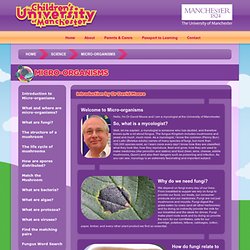
So, what is a mycologist? Well, let me explain, a mycologist is someone who has studied, and therefore knows quite a lot about fungus. The fungus Kingdom includes mushrooms and yeast and much, much more. As a mycologist, I know the common (Penny Bun) and Latin (Boletus edulis) names of many species of fungi, but more than 100,000 species exist, so I learn more every day! Why do we need fungi? We depend on fungi every day of our lives. How do fungi relate to micro-organisms? Fungi can be classified as micro-organisms along with Bacteria, Viruses, Algae and Protozoa and we will be looking at these in more detail in this section of the Children's University.
Adaptation. KS2 Science. Finding out how you move and grow.
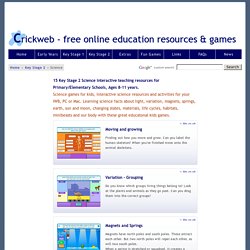
Can you label the human skeleton? When you've finished move onto the animal skeletons. Do you know which groups living things belong to? Look at the plants and animals as they go past. Can you drag them into the correct groups? Magnets have north poles and south poles. What does a year look like in space? © v2vtraining.co.uk The application consists of two sorting activities and one writing frame to support work towards the end of the unit. Solid, liquid and gas are called the three states of matter. Materials have different properties that make them useful for different jobs. Pupils can research information about teeth types, tooth structure and tooth decay. Use an information panel where pupils can research details about food groups and a balanced plate approach to a healthy diet.Balanced Plate lesson outline An information panel to explains the terms used in, and concepts behind, food chains.
Science Classroom. Science Discovery Days (Student worksheets provided) Scientific Method Unit & Safety Rules (Unit notes, worksheets, and lab ideas provided) Consumer Challenge (Student worksheets provided) Old Wives Tales Investigation (Student worksheets provided) Silly Science (Classification) (Student worksheet provided) Mystery Bags Film Canister Fun Bioglyphs (Student worksheets provided) Pottery Pieces Innovative Inventions - Internet project (Sites from the Kid Zone) (Student worksheet provided) Inventor's Challenge - Internet project (Sites from the Kid Zone) (Student worksheet provided) A Journey Through Time -Internet project (Sites from the Kid Zone) (Student worksheet provided) Science A to Z Puzzle (Student worksheet provided) Super Scientist Challenge (Student worksheets provided) Also check out ...
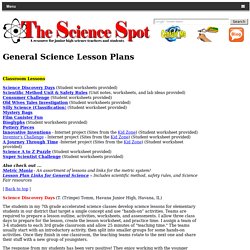
Metric Mania - An assortment of lessons and links for the metric system! | Back to top | Science Discovery Days (T. QCA Schemes of Work. Science ks1 & ks2 teaching resources. The current national curriculum programmes of study for science at key stages 1 and 2 have been disapplied with effect from 1 September 2013 for pupils in years 3 and 4 and are no longer statutory in relation to those year groups.

This means that schools are free to develop their own curriculums for science that best meet the needs of their pupils, in preparation for the introduction of the new national curriculum from September 2014 Science remains a compulsory national curriculum subject at all 4 key stages, and the existing programmes of study and attainment targets remain statutory for pupils in years 1, 2, 5 and 6 in 2013 to 2014, because they will underpin the statutory key stage 1 and 2 tests in 2014 and 2015.